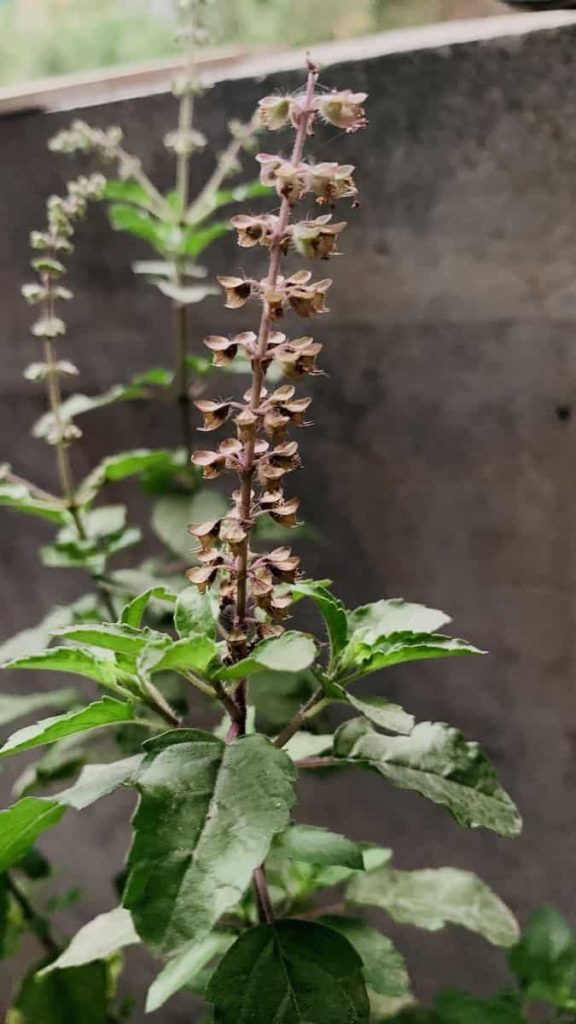The Tulsi plant is one of the common plants called Basil. Tulsi or Basil plants need more heat, adequate exposure to sunlight, well-drained soil, bright light, some moisture, moisture, air circulation, and lack of watering (it takes longer to dry in winter) are preferred to be kept indoors in winter for plant care. Let’s check out how to protect Tulsi in winter season in the USA below.
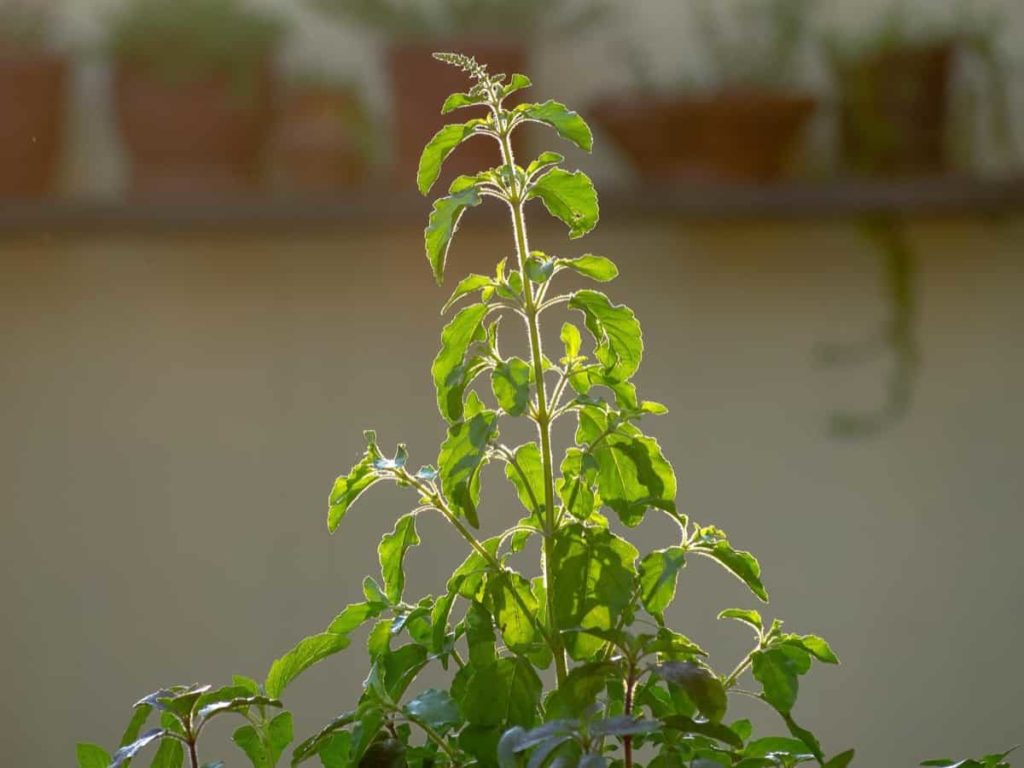
How to protect Tulsi in winter season in the USA
Tulsi growing conditions in the USA
Tulsi plant has many medicinal properties. It is hardy in zones 10 and 11 and can be grown year-round in the warmest parts of the United States, where it never gets cold. Tulsi plant can be grown outdoors annually or as a perennial houseplant for the rest of us. It is a heat-loving plant that grows year-round in the US Department of Agriculture plant hardiness zones 10 and 11. Tulsi can be grown perennially in these hot climates, but it can also be grown indoors or annually in colder climates. Kapoor Tulsi (Ocimum sanctum) is mainly grown in the USA.
Tulsi plant care in Winter
Temperature / Climate – Keep your plant indoors if it is freezing outside. Do not place it near an AC vent or just under a fan. It will cause your plant to struggle to survive and eventually die. Tulsi is susceptible to abnormal temperature changes, especially extreme cold, frost, or drafts. Intermittent or prolonged exposure to cold can result in Tulsi leaves turning brown, new leaves spoiling, or stunted growth.
As an herb traditionally grown in tropical climates, Tulsi does not tolerate cold well and will be damaged if its temperature drops below 10°C. Tulsi will also react badly if the temperature drops too much at night. If you periodically move it to a new environment and plant it in warm soil, you can save the plant from getting cold.
Humidity – To control humidity, you can moisten the Tulsi plant by watering it. It will help the Tulsi plant in the dry cold.
Soil requirement for growing Tulsi in winter in the USA
There is no need for a soil type for this plant that can be grown in any soil except those extremely salty, alkaline, or waterlogged. It prefers to grow in sandy loam soils with good organic matter and is considered ideal. Longer days and higher temperatures are ideal conditions for a Tulsi plant to grow well. Soil plays an important role, try to keep the soil well-drained; if it stays moist for a long time, it will encourage rot and root rot.
Fertilize your Tulsi plant to grow faster
Apply a balanced liquid fertilizer once every four weeks but reduce the fertilizer after the growing season. It is also beneficial to replace a two-inch layer of soil with compost every year or six months. Fertilizer plays an important role in the Tulsi plant growth, so if the plant is in the container, it must give fertilizer.
The soil in the container has a very limited source of nutrients, so we always have to fertilize the Tulsi plants every 25 to 35 days to grow faster and absorb all the nutrients from the soil in the pot.
In case you missed it: How to Grow Tulsi from Seeds: Soil, Plant Protection from Cold, Indoor, and Outdoor Growing Tips
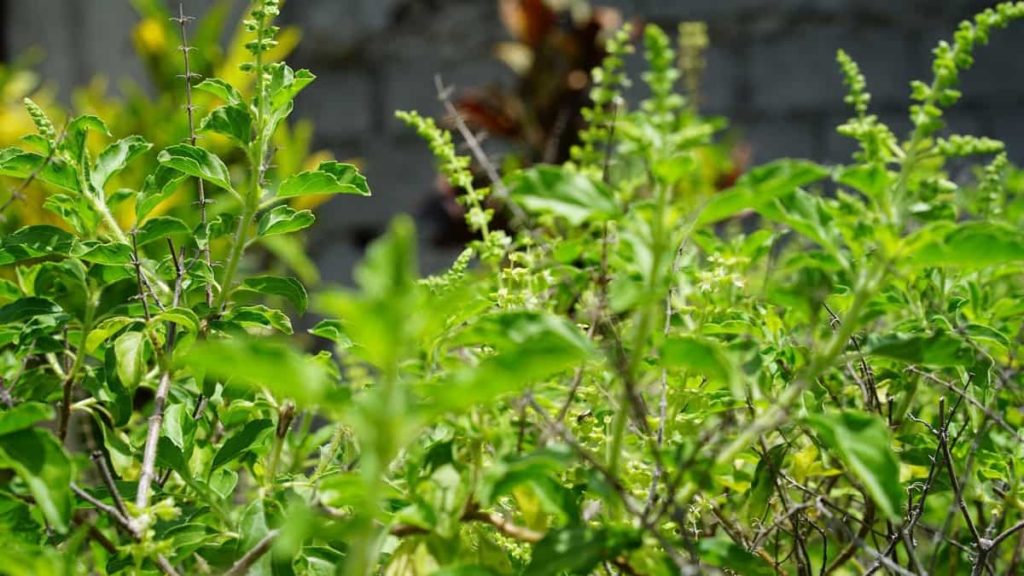
So, we have to decompose the Tulsi plant with organic manure, i.e., vermicompost or cow dung or leaf manure; cultivate 1 to 2 inches on the top layer of soil, and then we can add our organic manure to it. And after fertilizing, water can be added so that the Tulsi plant can absorb nutrients from the soil. It is good to give organic fertilizer as we will use Tulsi leaves, an organic fertilizer will help better plant growth, and the growth will be longer.
Pruning for promoting better growth
Prune Tulsi plant as needed throughout the year to control its size and promote better and more compact growth. Leaf pruning or slight pruning helps the plant survive before entering from the outside. Use a sharp knife to dig into the roots to help the plant transfer nutrients from the roots. Remove dried leaves in the winter season.
Save the Tulsi plant from dying
Check the positioning of the Tulsi plant – If you are wondering how to save the Tulsi plant from dying in winter, you should know that Tulsi cannot survive the cold. Please keep the Tulsi plant in a place where you can get sunlight.
Check the watering schedule and pattern – You should also watch your watering schedule. Ideally, you should examine the top layer of soil (approximately 2 inches). If the soil is dry, water the Tulsi plant carefully. Giving too much water can rot the roots, while drinking water underwater can make the leaves greasy.
Prune regularly – You need to prune your Tulsi plant regularly to keep it alive. It helps in removing dead parts or affected parts of the plant. Pruning helps in circulation and access to sunlight in all plant areas for better growth.
Fertilize properly – You should fertilize your Tulsi plant every fortnight. It will help your plant recover as it will have access to important nutrients. You can also add cow dung manure, tea leaves, and dried leaves.
Get rid of pests – Occasionally, you should also use pesticides. If you see pests attacking your Tulsi plant, you can use chemical pesticides or make pesticides at home.
Tips for growing Tulsi indoors
- Fill a pot with good quality soil and water it well. To make the soil very moist, add enough water, but do not add too much water as the soil may get wet.
- You can find special Tulsi plant pots online essential for proper growth. Even if you plan to plant Tulsi in an outdoor field, it is best to start growing it indoors before you go to bed outside. Sow seeds 1/4 inch below the surface. Since Tulsi seeds are very small, sprinkle the seeds on the soil, gently press them down with your fingers, or use a small tamper.
- Keep the soil moist before the Tulsi seeds germinate. In about 1-2 weeks, if you put water in the jar, the seeds will start to germinate so that you do not damage the seeds.
In case you missed it: Growing Tulsi Organically – Cultivation, Farming
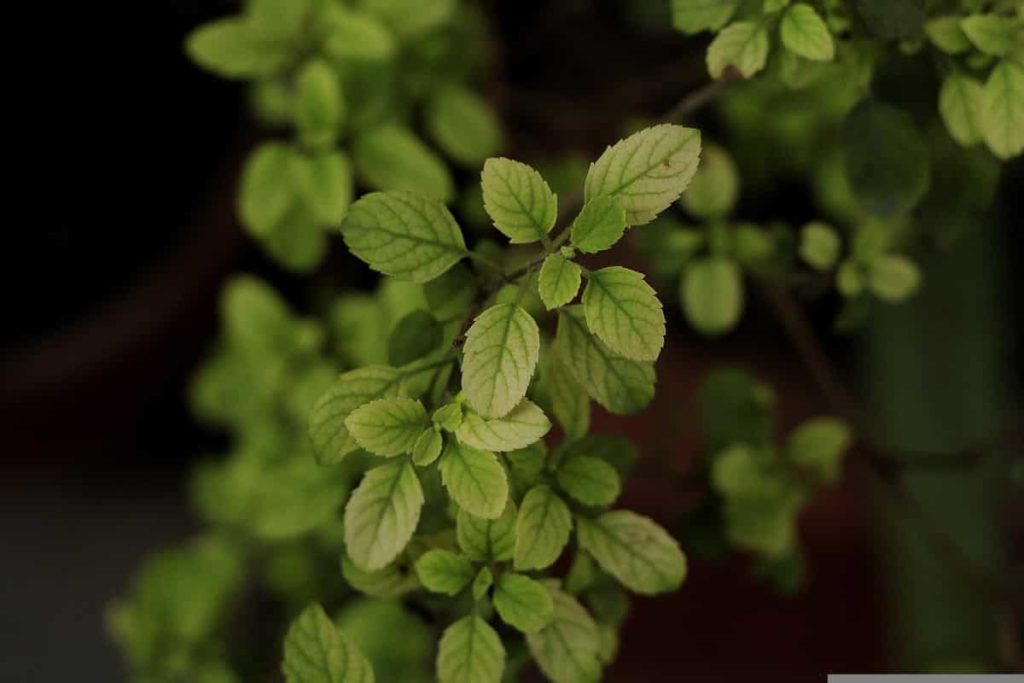
- Covering the top of the pot with plastic wrap will help retain moisture, but you will need to check the soil and add more water if appropriate.
- Place Tulsi near a window in a warm, sunny place. Your plant needs 6-8 hours of sunlight a day. Keep the pot in a place where it can get plenty of direct sunlight. If the temperature cools overnight, avoid leaving the plant near open windows or doors.
- You can easily grow Tulsi plants indoors by putting Tulsi seeds in a pot filled with soil and controlling sunlight and humidity.
- Nutritious soil will also help the Tulsi plant to grow faster as the Tulsi plant absorbs most of the nutrients in the initial period, i.e., the first three months.
Tips for growing Tulsi outdoors
- Proper soil
- Six hours of sun per day
- An inch of water per week
- Propagate using seeds or cuttings
Requirements for Tulsi seed germination
- A minimum temperature of 21°C is ideal for the Tulsi plant.
- Seeds that are small, dark black, or brown. The size of each seed does not exceed 0.3-0.5 mm.
- Soil is well-drained and rich in nutrients.
- Sprinkle seeds on the growing media.
- It is important to water regularly. Keep the soil moist at all times. If you water the plant more, it will not die.
- Tulsi plants can withstand extreme heat, but even mild cold can kill them. In cold weather, these plants are grown annually. The perennial Tulsi plant grows in US Hardiness Zone 10 and above.
Watering properly for better growth
You need to understand that every plant has different water needs, and you cannot water them in the same way. It is a common mistake to water people carelessly while growing a Tulsi plant, which may be why your Tulsi plant is dying. You may be over-watering or under-watering. Before watering your Tulsi plant, dip your finger into a 1–2-inch pot of soil to see if it is dry. If it feels damp, don’t water it.
Watering the Tulsi plant is enough to make the soil and not fill it with water. If the Tulsi plant leaves turn yellow, you water them too much, and the roots may start to rot. Let the soil dry completely and then re-water it, and never let the soil get wet. If the Tulsi leaves turn brown, you may be taking the plant underwater.
In case you missed it: Basil Pests and Diseases (Tulsi); Control Methods
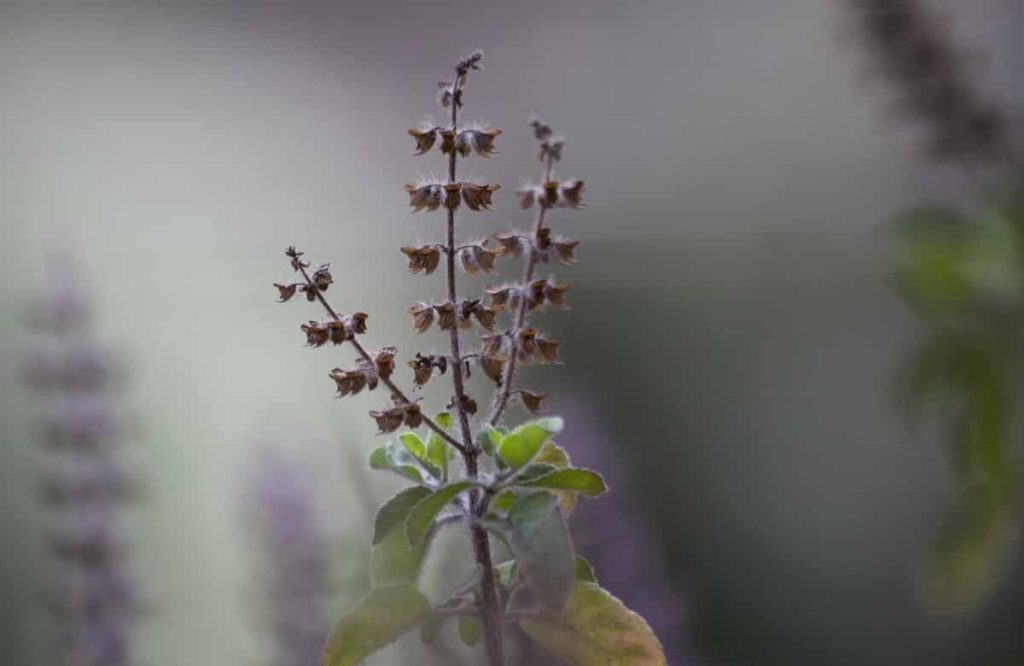
Give less water to the Tulsi plant in winter. You should water the Tulsi plant when the top 2-3 inches of soil is completely dry as there is not much evaporation during the winter and most of the water stays for a long time. If you water the soil carelessly every day in winter without checking it, its roots may start to rot.
Why does the Tulsi plant die in winter?
The Tulsi plant needs less water in winter than in summer. But too much-wet soil can weaken them. And, gradually, they will die if you do not take immediate precautions. But if you take care of them before they get hurt, you can save them from dying.
Reasons for Tulsi leaves turning brown
The most common causes of Tulsi leaf browning are more or less watering, temperature pressure, insufficient light, pests, or diseases. Brown leaves on Tulsi are usually signs of a plant health problem and should be addressed as soon as possible.
Pests and diseases management in tulsi plants
In general, it is free from pests and diseases. However, when grown in poor conditions, it can be attacked by common insects like mealybugs, aphids, spider mites, and sometimes whiteflies. To treat pests, use organic pesticides or insecticide soaps. Although Tulsi is a very hardy plant, some insects can attack it. These include aphids, spider mites, thrips, and scales, all of which suck the plant sap and its leaves turn brown.
It would help if you inspected Tulsi plants regularly to find pests. Carefully inspect both sides of the plant leaves and along the stems. Yellow spots on the leaves may form irregularly, or the whole leaf may be brown or yellow. Gardeners can treat them either by spraying pesticides on the plant with oil or soap or by using predatory insects such as ladybugs or weevils to rid the plant of the offensive insects.
How to protect the Tulsi plant from these pests?
The best way is to spray good quality neem oil on the affected leaves with a few drops of soapy water and save your Tulsi plant from dying. Also, remember to never spray pesticides (in this case, neem oil) in the presence of sunlight, as this will burn the leaves. Always apply pesticides and insecticides in the evening. Do not spray it regularly and wait at least 21 days before spraying again.
When and how to harvest Tulsi
In the growing season, cut the aromatic leaves of your Tulsi plant. Once your plant reaches a height of 8 inches, take a pair of scissors and cut a large leaf or a whole branch according to your needs. Use fresh leaves on the day you harvest because they die quickly. When the Tulsi plant reaches a height of about one foot, you can start harvesting Tulsi.
In case you missed it: Tulsi Oil Extraction Process, Benefits, Uses
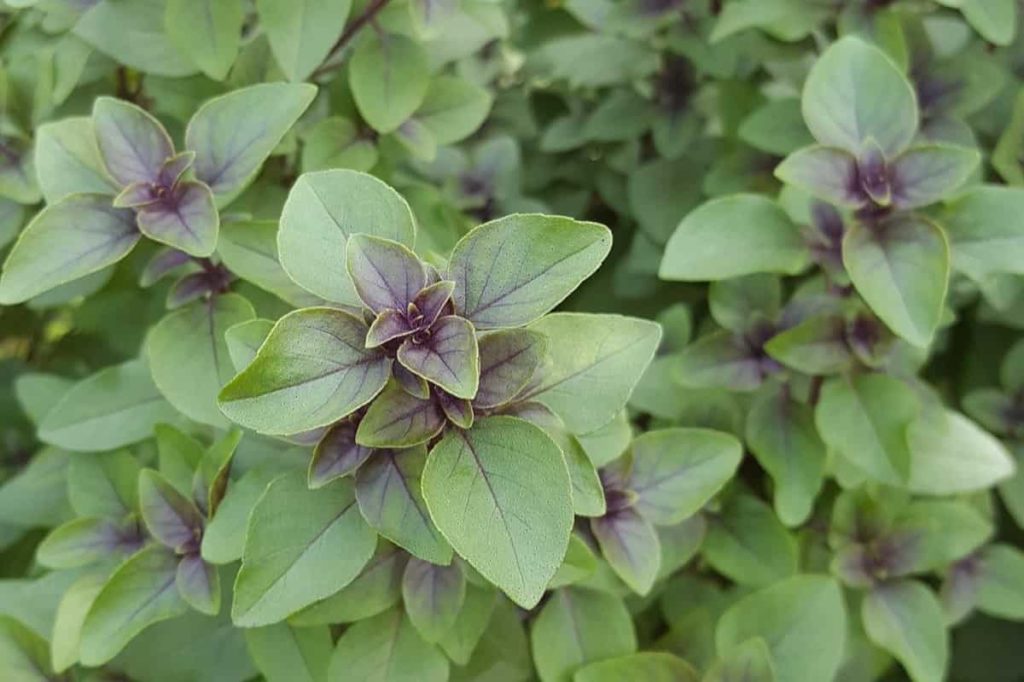
To help develop the habit of a shrubby plant, remove the growing points, which will increase the yield. It should be ready for harvest about 40 days after germination and perform best with intermittent pruning. The Tulsi plant can continue to produce for many years if planted slowly with leaves or branches.
Frequently asked questions for growing Tulsi (FAQ)
Can Tulsi grow in Florida?
This variety of sacred Tulsi grows well in our sub-tropical climate, especially in Central Florida. According to mint family specimens, Tulsi has a square stem with opposite leaves and small flowers arranged along a raceme atop the plant.
Does Holy Tulsi grow in America?
Easily propagated by seed or cutting, Tulsi has grown annually in most of the USA, but it will grow as a perennial in hot climates and as an indoor plant under the right conditions.
Why are my Tulsi leaves curling?
Tulsi leaves curl in response to environmental pressures such as unbalanced water, poor soil, improper lighting, and temperature fluctuations that shock and impair its growth. Fungal diseases and sap-sucking insects such as thrips and aphids also weaken and damage the leaf structure.
How do I know if my Tulsi is in more water?
Overwatered Tulsi will initially produce yellow, yellow leaves, often starting upwards from the lower leaves. Wilting the leaves soon follows, and you may notice an unpleasant odor from the soil. The soil will get wet, and if you remove the plant from the pot, the roots will turn brown and brown or black.
In case you missed it: Tulsi Farming Project Report (Basil), Cultivation Economics
Why are my Tulsi leaves deformed?
Tulsi leaves appear damaged by too little sunlight, certain diseases or pests, or too little water. A healthy Tulsi plant needs to identify the cause and correct it.
How do you grow holy Tulsi in California?
Use light, well-drained soil rich in organic matter, although holy Tulsi will tolerate poor soil well. Your plant will tolerate some shade, so full sun is not necessary. Water it, but do not get wet, and prune the leaves as needed, as you would with a typical sweet Tulsi plant.
- How to Make Houseplants Bushy: Effective Tips and Ideas
- Innovative Strategies for Boosting Coconut Pollination and Yield
- Pollination Strategies for Maximum Pumpkin Yield
- The Complete Guide to Chicken Fattening: Strategies for Maximum Growth
- Natural Solutions for Tulip Problems: 100% Effective Remedies for Leaf and Bulb-Related Issues
- Revolutionizing Citrus Preservation: Towards a Healthier, Greener Future
- Natural Solutions for Peony Leaf and Flower Problems: 100% Effective Remedies
- Maximizing Profits with Avocado Contract Farming in India: A Comprehensive Guide
- Natural Solutions for Hydrangea Problems: 100% Effective Remedies for Leaf and Flowers
- The Ultimate Guide to Choosing the Perfect Foliage Friend: Bringing Life Indoors
- From Sunlight to Sustainability: 15 Ways to Use Solar Technology in Agriculture
- The Ultimate Guide to Dong Tao Chicken: Exploring from History to Raising
- The Eco-Friendly Makeover: How to Convert Your Unused Swimming Pool into a Fish Pond
- Mastering the Art of Delaware Chicken Farming: Essentials for Healthy Backyard Flocks
- 20 Best Homemade Fertilizers for Money Plant: DIY Recipes and Application Methods
- How to Craft a Comprehensive Free-Range Chicken Farming Business Plan
- Brighten Your Flock: Raising Easter Egger Chickens for Beauty and Bounty
- How to Optimize Your Poultry Egg Farm Business Plan with These Strategies
- Subsidy for Spirulina Cultivation: How Indian Government Schemes Encouraging Spirulina Farmers
- Ultimate Guide to Raising Dominique Chickens: Breeding, Feeding, Egg-Production, and Care
- Mastering the Art of Raising Jersey Giant Chickens: Care, Feeding, and More
- Ultimate Guide to Raising Legbar Chickens: Breeding, Farming Practices, Diet, Egg-Production
- How to Raise Welsummer Chickens: A Comprehensive Guide for Beginners
- How to Protect Indoor Plants in Winter: A Comprehensive Guide
- Ultimate Guide to Grow Bag Gardening: Tips, Tricks, and Planting Ideas for Urban Gardeners
- Guide to Lotus Cultivation: How to Propagate, Plant, Grow, Care, Cost, and Profit
- Agriculture Drone Subsidy Scheme: Government Kisan Subsidy, License, and How to Apply Online
- Ultimate Guide to Raising Araucana Chickens: Breed Profile, Farming Economics, Diet, and Care
- Bringing Hydroponics to Classroom: Importance, Benefits of Learning for School Students
- Ultimate Guide to Raising Polish Chickens: Breed Profile, Farming Economics, Diet, and Care
- Ultimate Guide to Raising Australorp Chickens: Profile, Farming Economics, Egg Production, Diet, and Care
- Silkie Chicken Farming: Raising Practices, Varieties, Egg Production, Diet, and Care
- Sussex Chicken Farming: Raising Practices, Varieties, Egg Production, Diet and Care
- Homemade Feed Formulations for Livestock: Discover Cost-effective Starter to Finisher Feed Recipes
- 20 Best Pig Weight Gain Supplements: Top Swine Weight Gain Formulas
- Ultimate Guide to Elderberry Farming: Propagation, Planting, Yield, Cost, and Profit
